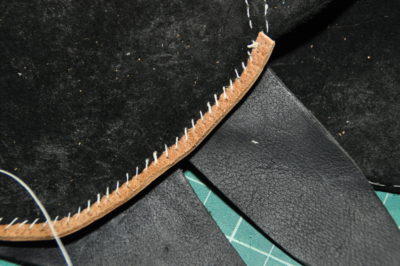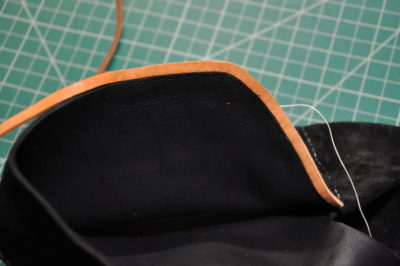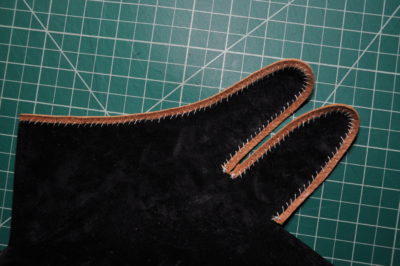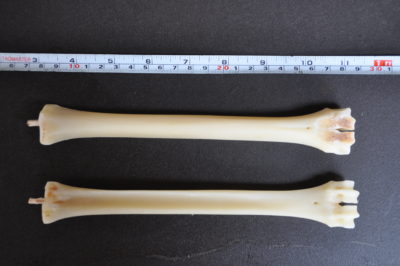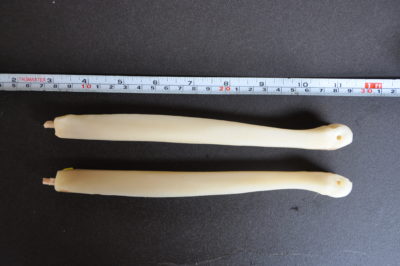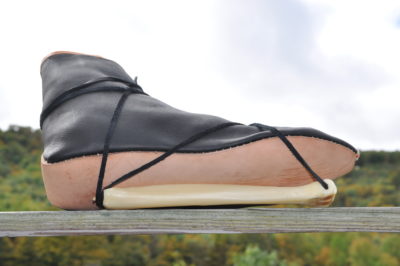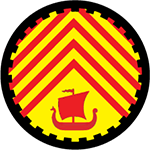
Shoes by Robert
Bone Ice Skates
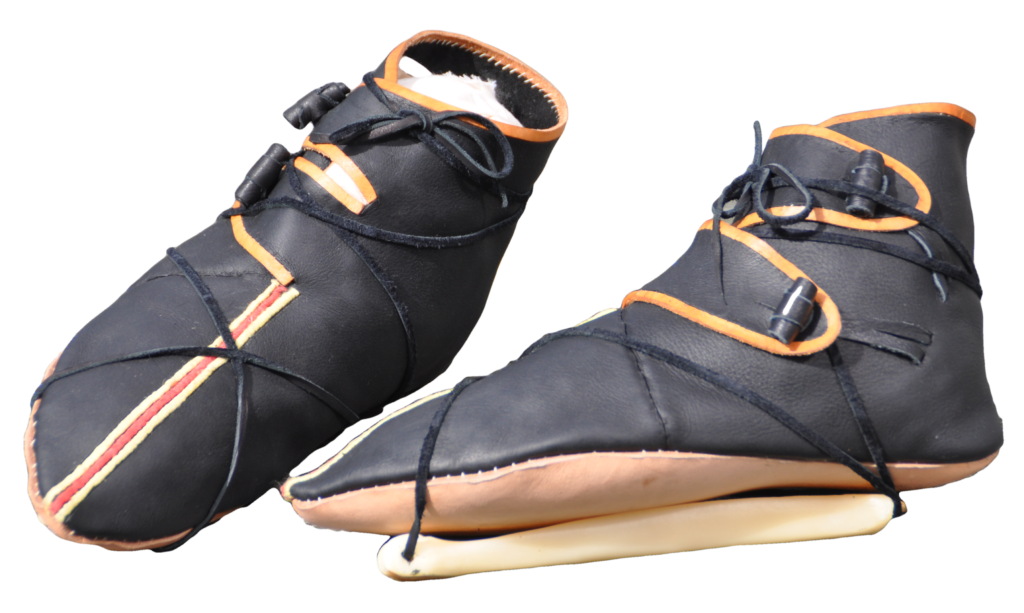
Following the creation of the page below, this project was entered into the Æthelmearc Arts & Sciences Championship, where it received the highest score.
The documentation (much more extensive than the notes on this page) can be found on Academia.edu at https://www.academia.edu/37589426/10th-Century_Embroidered_Turnshoes_on_Bone_Ice_Skates.pdf
A video of the first time on ice with the skates is at https://www.youtube.com/watch?v=lqxlzanHsWQ
Thousands of archaeological finds of bone skates prove that people took to the ice during our period of study as well as long before and long after.
For this pair of skates, I have incorporated a pair of vamp-embroidered, 10th-century shoes based on the pattern described by Volken (Dorestad - Q, p. 373). This pair of shoes debuts the use of boar's needles to embroider, as well as topbands made of leather strips attached by edge/edge stitching.
Note that no paired shoes/skates have been found. It is assumed that any kind of period shoe will work with bone skates, but it is possible that specialized footwear was worn.
10 Interesting Facts About Bone Skates:
- They may or may not have holes through the bones; a person can just stand on them; they do not need to be bound to the foot (some sources mention that binding is used only by children and novice skaters).
- If they do have holes, they are often just in the front for toe bindings; many holes are roughly made, as by a knife tip, rather than being drilled.
- If there is a hole at the rear end, it is most often parallel to the bone and holds an inserted peg of wood or iron, rather than going through it at a right angle, although those exist as well; the rear peg or holes allows a single leather strap binding to be tightened around both toes and ankle.
- The front tip may or may not be angled upward.
- The top is often flattened by grinding and sometimes has transverse grooves to help grip the shoe soles.
- Cow, horse, deer, or sheep leg bones can be used to make skates, and the bones may or may not have been split lengthwise; the large majority are made of cow or horse bones.
- They are not used by pushing off with the feet sides or tips, but rather by pushing off the ice with one iron-shod pole between one's legs, or by a pair of iron-tipped poles.
- Youth often wore them and used their poles to tilt against one another, often suffering wounds on their head and broken bones as a result.
- They have a long history, extending from the Bronze Age through the 1900s. Thousands of period skates have been found at many locations where winter weather would have allowed them to be used.
- We have at least four period sources that talk about their use, one even illustrated.
For my pair, I chose to use deer bones because they were easy to obtain on eBay. I chose to drill a hole through the front and add a peg to the rear end for bindings, because I am a novice skater. I chose to flatten both top and bottom in order to make them comfortable and stable. As for a pole, I purchased some metal cones on Amazon.com and put one on the end of a sturdy sapling.
Standing on these skates while wearing the shoes is not uncomfortable, however these bones seem too short and perhaps too frail for my 175 lbs. Deer bones may have been used mainly by youth. A pair of horse bones will be tried for comparison, and are likely to be more comfortable to stand on as well as sturdier.
Sources, References, and Related Reading for Bone Skates
Balfour, H. 1898. "Notes on the Modern Use of Bone Skates" in Reliquary 4, 29-37.
Berg, G. 1971. "Skates and Punt Sleds: Some Scandinavian Notes" in Vriendenboek voor A. J. Kempers. Meertens, P., ed. Arnhem. 4-13.
Blauw, W. 2001. Van Glis tot klapschaats – Schaatsen en schaatsenmakers in Nederland, 1200 tot heden. Franeker. [Dutch or German; the early part of the book appears to be about bone skates and then early medieval wooden ones with iron blades, based on accompanying illustrations; need a translation!]
Choyke, A. M. 1999. "Bone Skates: Raw Material, Manufacturing and Use" in Pannonia and Beyond: Studies in Honor of László Barkóczi, A. Vaday, ed. (Archaeological Institute of the Hungarian Academy of Sciences, Budapest). 148-156, 651-654.
Choyke, A. M., and L. Bartosiewicz. 2005. "Skating with Horses: Continuity and Parallelism in Prehistoric Hungary" in Revue de Paléobiologie 10. 317-26.
Coatsworth, E., and G. Owen-Crocker. 2018. Clothing the Past: Surviving Garments From Early Medieval to Early Modern Western Europe. (Brill, Leiden). 356-358.
Edberg, R. and J. Karlsson. 2016. "Bone skates and young people in Birka and Sigtuna" in Fornvännen 111:1. 7-16.
FitzStephen, W. c. 1173. "A Description of the Most Noble City of London" in An Annotated Translation of the Life of St. Thomas Becket by William Fitzstephen. Trans. L. Gourde, 1943, Master's Thesis. Paper 622. 15-16.
Formenti, F., and A. Minetti. 2007. "Human locomotion on ice: the evolution of ice-skating energetics through history" in The Journal of Experimental Biology 210. 1825-1833.
Formenti, F., and A. Minetti. 2008. "The first humans travelling on ice: an energy-saving strategy?" in Biological Journal of the Linnean Society 93. 1–7.
Herman, O. 1902. "Knochenschlittschuh, Knochenkufe, Knochenkeitel: Ein Beitrag zur näheren Kenntnis der prähistorischen Langknochenfunde" in Mittheilungen der Anthropologischen Gesellschaft in Wien, 32. 217-238. [German, but with nice reconstruction drawings and a plate showing a pushing stick.]
Klindt-Jensen, O. 1955. "Economic and Daily Life at Vallhager" in Vallhager: A Migration Period Settlement on Gotland / Sweden, ed. M. Stenberger, Ejnar Munksgaards Forlag: Copenhagen, Denmark. 857-858, 861-862.
Küchelmann, H. C., and P. Zidarov. 2005. "Let's Skate Together! Skating on Bones in the Past and Today" in From Hooves to Horns, from Mollusc to Mammoth: Manufacture and Use of Bone Artefacts from Prehistoric Times to the Present, Proceedings of the 4th Meeting of the ICAZ Worked Bone Research Group at Tallinn, 26th-31st August 2003, H. Luik et al., eds., Tallinn: Ajaloo Instituut. 425-45.
Küchelmann, H. C., and P. Zidarov. [Accessed 2018-09-19]. "Bone Skates Database" at http://www.knochenarbeit.de/en/index.php?page=bone_skates.
Lauwerier, R. C. G. M., and R. Van Heeringen. 1998. "Skates and Prickers from the Circular Fortress of Oost-Souburg, The Netherlands (AD 900-975)" in Environmental Archaeology 3. 121-26.
Luik, H. 2000. "Luust uisud Eesti arheoloogilises leiumaterjalis [Bones skates in the archaeological material of Estonia]" in Eesti Arheoloogia Ajakiri [Estonian Archeology Magazine] 4:2. 129-150 [English summary 148-150].
Lyublyanovics, K. 2008. Before the Cattle Trade. Animals and People in Muhi, A Medieval Hungarian Village. MA Thesis in Medieval Studies, Central European University, Budapest. 77-83, 163-166.
MacGregor, A. 1975. "Problems in the Interpretation of Microscopic Wear Patterns: The Evidence from Bone Skates" in Journal of Archaeological Science 2. 385-90.
MacGregor, A. 1976. "Bone Skates: A Review of the Evidence" in Archaeological Journal 133. 57-74.
MacGregor, A. 1980. Skeletal materials: their structure, technology and utilisation c. A.D. 400-1200. Durham theses, Durham University. 284-299.
MacGregor, A. 1985. Bone, Antler, Ivory & Horn. Croon Helm, London. 141-144.
Magnus, O. 1539. Carta Marina et descriptio septemtrionalium terrarum. [Map with legend depicting ice skaters in Section F. Several versions linked via Wikipedia at https://en.wikipedia.org/wiki/Carta_marina.]
Magnus, O. 1555. Description of the Northern Peoples. [Historia de Gentibus Septentrionalibus, trans. P. Fisher and H. Higgens, ed. P. Foote, The Hakluyt Society, London, 1996. Second Series, No. 182.] 57-59, 86.
Manojlović-Nikolić, V. 1997: "Средњовековне клизаљке из Вршачког музеја [The medieval skates from the Museum of Vršac]" in Glasnik Srpskog arheološkog društva 13. 349-357 [English summary 357].
Manojlović-Nikolić, V. 2010. "Коштане клизаљке са средњовековних насеља у Војводини [Bone skates from medieval settlements in Vojvodina]" in Istraživanja 21. 31-41 [English summary 41].
Munro, R. 1893. "Notes on Ancient Bone Skates" in Proceedings of the Society of Antiquaries of Scotland 28. 185-197.
Mygland, S. 2007. The Bryggen Papers, Main Series, No. 7: Children in Medieval Bergen. Bergen. 41.
Petényi, S. 1994. Games and Toys in Medieval and Early Modern Hungary. Krems, Austria. 111-121.
Roes, A. Bone and Antler Objects from the Frisian Terp-Mounds. 1963. H. D. Tjeenk Willink & Zoon N. V., Haarlem. 57-59, plate XLVIII.
Schietzel, K. 2018. Spurensuche Haithabu. Wachholtz Verlag, Neumünster. 218-219. [German, but with some nice color photos of bone skates and reconstruction drawings.]
Smith, C. R. 1842. "Ancient Bone Skate Found in Moorfields" in Archaeologia 29. 397-399.
Thurber, B. 2013. "The Similarity of Bone Skates and Skis" in Viking and Medieval Scandinavia 9. 197-214.
Vilppula, H. 1940. "Luuluistimista" in Suomen Museo 47. 51-58 [illustrations].
West, B. 1982. "A Note on Bone Skates from London" in Transactions of the London and Middlesex Archaeological Society 33. 303.
Last updated October 15, 2018.
